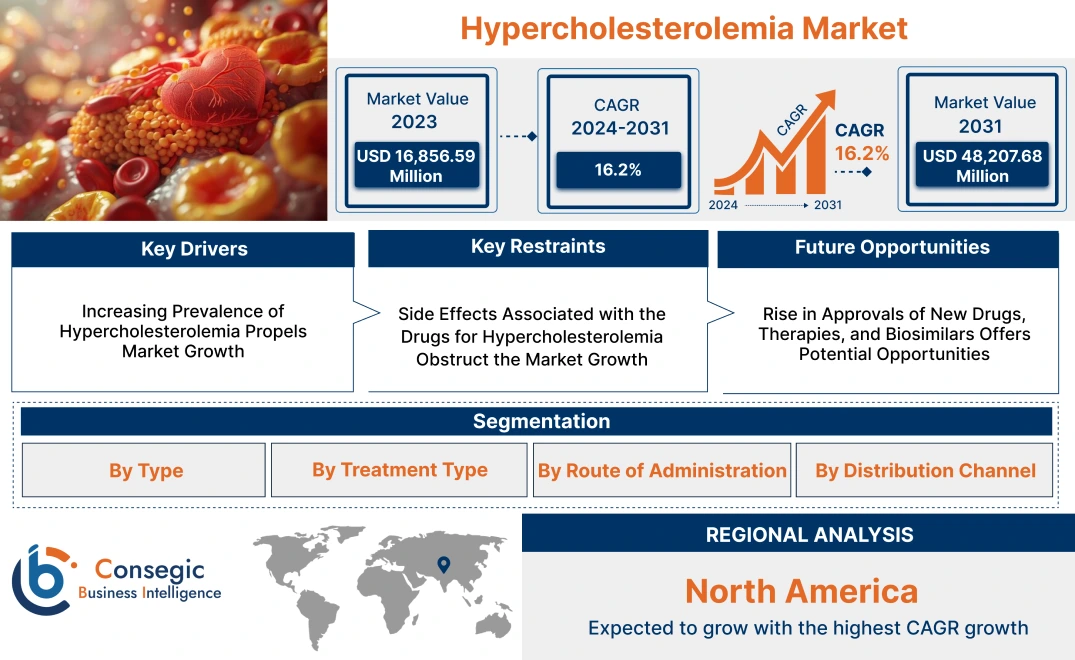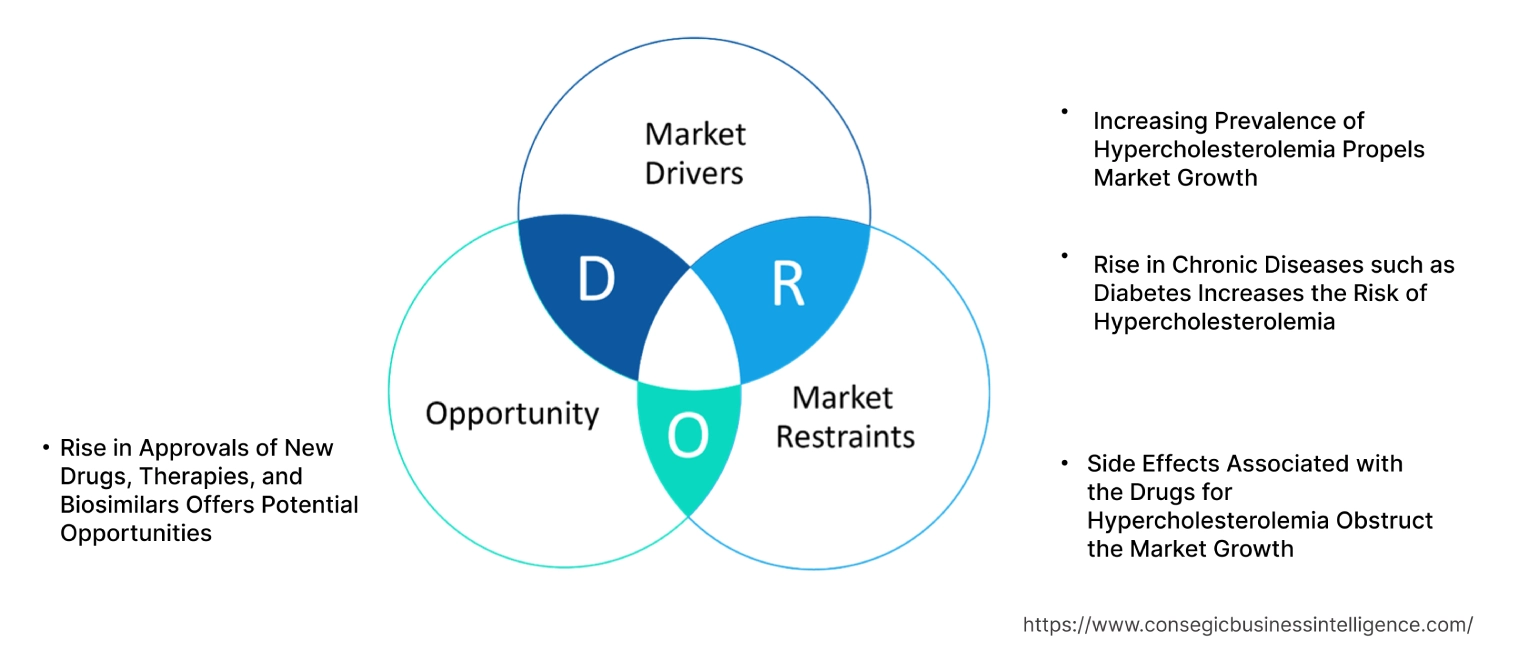Hypercholesterolemia Market Size:
Hypercholesterolemia Market size is estimated to reach over USD 63,607.67 Million by 2032 from a value of USD 19,189.23 Million in 2024 and is projected to grow by USD 21,948.29 Million in 2025, growing at a CAGR of 16.20 % from 2025 to 2032.
Hypercholesterolemia Industry Scope & Overview:
Hypercholesterolemia, also known as high cholesterol, is a medical condition in which there is a rise in the blood cholesterol level. It is a condition that causes low-density lipoprotein (LDL) in the blood. Hormone synthesis, bile acid synthesis, and cell membrane structure are the factors dependent on the cholesterol level. As per the analysis, cholesterol is a waxy material produced by the liver and is found in various food items. Elevated cholesterol levels have been linked to atherosclerosis, or the buildup of plaque in the arteries. This accumulation causes the arteries to narrow down, limiting the blood flow, and raising the risk of heart attacks and strokes among other cardiovascular illnesses. The main causes of high cholesterol include dietary decisions, heredity, aging, a sedentary lifestyle, and certain medical conditions. A healthy lifestyle and controlling high blood pressure helps in maintaining cholesterol levels.
Hypercholesterolemia Market Insights:
Hypercholesterolemia Market Dynamics - (DRO) :
Key Drivers:
Increasing Prevalence of Hypercholesterolemia Propels Market Growth
The prevalence of hypercholesterolemia is continuously increasing and poses a threat to public health. Low levels of physical activity and diets that contain high refined carbohydrates and saturated fats cause blood cholesterol levels to rise. As per the analysis, the risk of developing this condition is further increased by underlying medical conditions such as obesity, diabetes, and hypertension. The number of people suffering from this condition worldwide has escalated substantially mainly because of factors such as the rising condition of chronic stress which is a factor that influences this condition.
- According to the Australian Bureau of Statistics, in December 2023, an estimated 2.1 million people were self-diagnosed with high cholesterol in 2022.
Thus the rise in the prevalence of this condition is boosting the hypercholesterolemia market growth.
Rise in Chronic Diseases such as Diabetes Increases the Risk of Hypercholesterolemia
Chronic conditions such as obesity and diabetes are linked to aberrant lipid metabolism, which raises levels of triglycerides and low-density lipoprotein cholesterol (LDL-C). Similarly, dyslipidemia, which is characterized by increased LDL-C and triglyceride levels, is frequently associated with diabetes, particularly type-2 diabetes. Based on the analysis, Diabetes-related insulin resistance and hyperglycemia cause lipid abnormalities speeding the risk of cardiovascular disorders.
The number of people suffering from diabetes worldwide has escalated substantially and is predicted to further increase in the future.
- According to the World Health Organization (WHO) report in 2021, over 422 million people worldwide suffer from diabetes, and the cases as well as the prevalence of diabetes have been steadily increasing since 1990.
Thus, the rise in cardiovascular diseases and chronic diseases is boosting the hypercholesterolemia market growth.
Key Restraints :
Side Effects Associated with the Drugs for Hypercholesterolemia Obstruct the Market Growth
The drugs for the treatment of this pose certain side effects which are harmful to individuals. It is a condition with high levels of bad cholesterol. The drugs used to treat this condition such as statin, PCSK 9 inhibitors, and others have a variety of side effects. As per the analysis, the side effects generally include gastrointestinal symptoms such as nausea, headaches, diarrhea, and weakness or pain in muscles. Less frequent but more dangerous side effects include a higher chance of developing diabetes, memory loss, and severe muscle disorder.
- For instance, according to the Clinic, some side effects of hypercholesterolemia drugs include muscle pain and damage, liver damage, increased blood sugar leading to type 2 diabetes, and neurological side effects.
Thus, the side effects of drugs are hindering the market.
Future Opportunities :
Rise in Approvals of New Drugs, Therapies, and Biosimilars Offers Potential Opportunities
The increasing prevalence of hypercholesterolemia is increasing the research and development activities in this condition and therapies. The approval of novel targeted drugs, therapies, and biosimilars is a possible trend to influence the hypercholesterolemia market. A biosimilar is a medicine that is similar to an already approved biological drug. To guarantee the safety and efficacy of the biosimilars and various drugs before their release in the market, regulatory bodies, including the FDA, and EMA, have introduced strict approval procedures. No drugs or medicines are released publically before their approval.
- In December 2023, the FDA Committee for Medicinal Products for Human Use (CHMP) issued a positive judgment about the marketing authorization of Esperion's drug Nexletol (bempedoic acid) Tablet and Nexlizet (bempedoic acid and ezetimibe) Tablet for the treatment of patients with this condition. Significantly the high potential of drugs and biosimilars will eventually lower the cost of treatment in the future.
Thus, as per the analysis, these targeted drugs, therapies, and biosimilars will bring hypercholesterolemia market opportunities in the near future.
Hypercholesterolemia Market Segmental Analysis :
By Type:
Based on type, the market is bifurcated into genetic and acquired.
Trends in the Type:
- Gene therapies that target LDL cholesterol levels have shown promise, indicating a shift towards more effective and targeted treatments.
- The acquired hypercholesterolemia segment is largely influenced by lifestyle factors such as diet, obesity, and sedentary habits. The increasing prevalence of these conditions globally is expected to sustain the demand for cholesterol management solutions.
In 2024, the genetic segment accounted for the largest market revenue in the hypercholesterolemia market, and it is also expected to grow at the fastest rate over the forecast period.
- Genetically acquired hypercholesterolemia is the term used to describe conditions in which genetic factors, rather than lifestyle choices, are the primary cause of elevated cholesterol levels.
- Familial hypercholesterolemia is a common form that is usually inherited in an autosomal dominant pattern.
- Mutations in genes that control LDL receptor function cause impaired blood clearance of LDL cholesterol.
- To lower cholesterol and lower the risk of cardiovascular disease, treatment often consists of a combination of pharmacological interventions such as PCSK9 inhibitors or statins and lifestyle modifications.
- Sun Pharma, in May 2022, launched its first-in-class lipid-lowering drug known as Brillo. It is advised for people with inherited genetic disorder that causes high cholesterol levels or established heart disease where cholesterol levels remain high, despite lifestyle changes and the use of a maximum tolerated dose of statins.
- Thus, the above factors are boosting the hypercholesterolemia market trends.
By Treatment Type:
The treatment type is categorized into statins, bile acid resins, fibric acid derivatives, PCSK 9 inhibitors, niacin, and others.
Trends in the Treatment Type:
- Increasing focus on tailoring treatments based on genetic profiles and individuals are potential trends influencing the segment.
- The growing trend towards combining therapies helps to achieve better cholesterol levels.
The statins segment accounted for the largest revenue share of the total 23.89% in the year 2024.
- Statins are a class of drugs that are used to treat hypercholesterolemia, a condition caused by elevated blood cholesterol.
- Statins lower the amount of cholesterol produced in the liver by blocking the HMG-CoA reductase, and it lowers the production of cholesterol in the liver by blocking the enzymes.
- Lower LDL levels are significant risk factors for cardiovascular diseases.
- Furthermore, as per the analysis, statins may slightly lower triglycerides and raise HDL cholesterol.
- Statins are generally prescribed and consumed orally. The statins available to use generally include atorvastatin, fluvastatin, and lovastatin. Atorvastatin is the most prescribed statin.
- Many companies launched a new and more effective version of atorvastatin.
- According to a paper published in NLM in February 2024, it was found that Statins, approved by the FDA, inhibit the HMG-CoA reductase enzyme, lowering LDL and cholesterol levels. High-risk patients need higher-intensity statins, with a focus on dosing, interactions, and monitoring strategies for optimal management.
- Thus, the use of statins maintains the LDL levels, thus boosting the hypercholesterolemia market demand.
PCSK 9 inhibitor segment is anticipated to register the fastest CAGR during the forecast period.
- A class of drugs known as PSCK-9 (Kexin type 9) is used to lower blood cholesterol levels.
- They function by blocking the PSCK9 protein, which typically lessens the liver's capacity to eliminate low-density lipoprotein (LDL) cholesterol from the blood.
- Because of these, the chance of cardiovascular conditions such as strokes is decreased.
- PCSK9 inhibitors include drugs alirocumab and evolocumab.
- Evolocumab binds to a protein called PCSK9, which normally degrades LDL receptors in the liver. By blocking PCSK9, evolocumab increases the number of LDL receptors, leading to a more efficient removal of LDL cholesterol from the bloodstream.
- As mentioned in a paper published in NLM in February 2024, PCSK9 inhibitors, like Evolocumab and Alirocumab, lower LDL cholesterol by 50%-60% by preventing LDL receptor destruction. These drugs offer alternative treatments for patients intolerant to statins or with severe hypercholesterolemia, complementing statin therapy for cardiovascular disease risk management.
- This reduction in LDL cholesterol levels can help decrease the risk of heart attack, stroke, and other cardiovascular events, thus driving the demand for the segment.
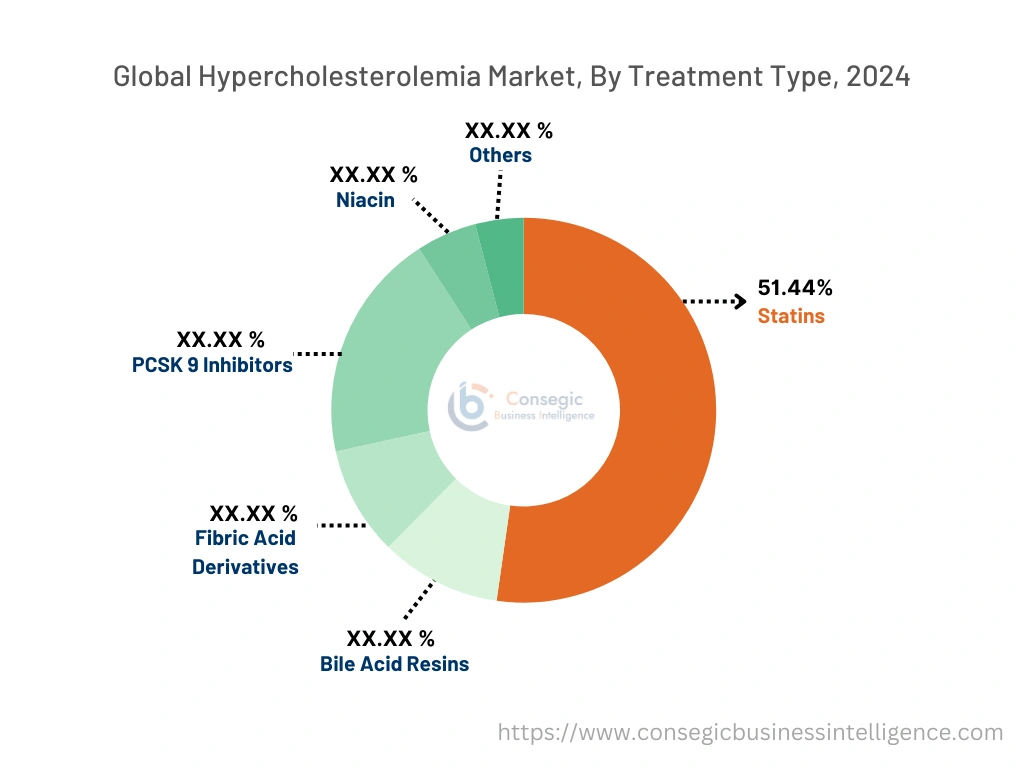
By Route of Administration:
The route of administration segment is categorized into oral and injectable.
Trends in the Route of Administration:
- There is a growing trend for the use of injectable biologics, as they are administered subcutaneously and are effective in lowering LDL levels.
The oral segment accounted for the largest revenue of the total hypercholesterolemia market share in 2024.
- The oral route is the most common route for the administration of drugs to treat this condition.
- Cholesterol-lowering drugs mainly statin, fibrates, bile acid resins, and other drugs are administered orally in the form of tablets or capsules.
- These drugs function by moving toward different parts of the metabolism of cholesterol, such as stopping the liver's production of cholesterol, decreasing the intestine's absorption of cholesterol, or speeding up the removal of cholesterol from the blood system.
- For the administration of medications, the oral route has various benefits such as patient compliance, convenience, and ease of use. Oral medications are simple and self-administered at home without a doctor's supervision, making it possible for patients to successfully follow treatment plans.
- Various drugs are being introduced for the treatment of this condition that are administrated orally.
- In 2023, Lupin received FDA approval for pitavastatin tablets to reduce (LDL-C). These tablets are administrated orally for the treatment.
- Thus, due to its various benefits, the oral route of administration is boosting the market trends.
The injectable segment is anticipated to register the fastest CAGR during the forecast period.
- Certain medication that lowers cholesterol is injected, most commonly by intravenous infusion, to reduce the cholesterol level in patients as it achieve adequate control of medications.
- One such class of drug is known as PCSK9 inhibitors, which are monoclonal antibodies that work by targeting the PCSK9 protein to lower LDL cholesterol levels.
- According to Cleaveland Clinic, PCSK9 inhibitors, like Evolocumab and Alirocumab, are injectable medications that lower LDL cholesterol by preventing LDL receptor destruction. They are used for patients with high cholesterol unresponsive to statins.
- Therefore, due to their quick action on controlling cholesterol, they have lately been holding a high revenue share.
By Distribution Channel:
The distribution channels segment is categorized into online and offline. The offline segment is further categorized into hospital pharmacies, retail pharmacies, and others.
Trends in the Distribution Channel:
- Pharmaceutical companies are increasingly selling medications for cholesterol through online pharmacies and telehealth services.
The offline segment accounted for the largest market revenue of the overall hypercholesterolemia market share in 2024.
- Offline stores are easy to access, offer competitive prices on drugs, and provide patients with information and support on how to use medicines and drugs safely and effectively.
- In addition, they are often the first point of contact for patients after being diagnosed with this condition.
- The high benefits and easy availability of drugs across offline stores are creating lucrative hypercholesterolemia market trends.
- Therefore, owing to the comfort they provide to patients, often on an immediate basis, offline segments have been making the largest revenue.
The online segment is expected to hold the highest CAGR over the forecast period.
- The increasing sale of pharmaceutical products through e-commerce platforms is expected to provide lucrative trends for online pharmacies over the forecast period.
- According to the report by the National Investment Promotion and Facilitation Agency in June 2021, the Indian e-pharmacy sales in 2019 accounted for USD 0.5 billion which is expected to reach USD USD 4.5 billion compounded rate of 44%.
- Thus, the growing e-pharmacy sales are providing lucrative opportunities for segment growth over the forecast period.
Regional Analysis:
The regional segment includes North America, Europe, Asia Pacific, the Middle East and Africa, and Latin America.
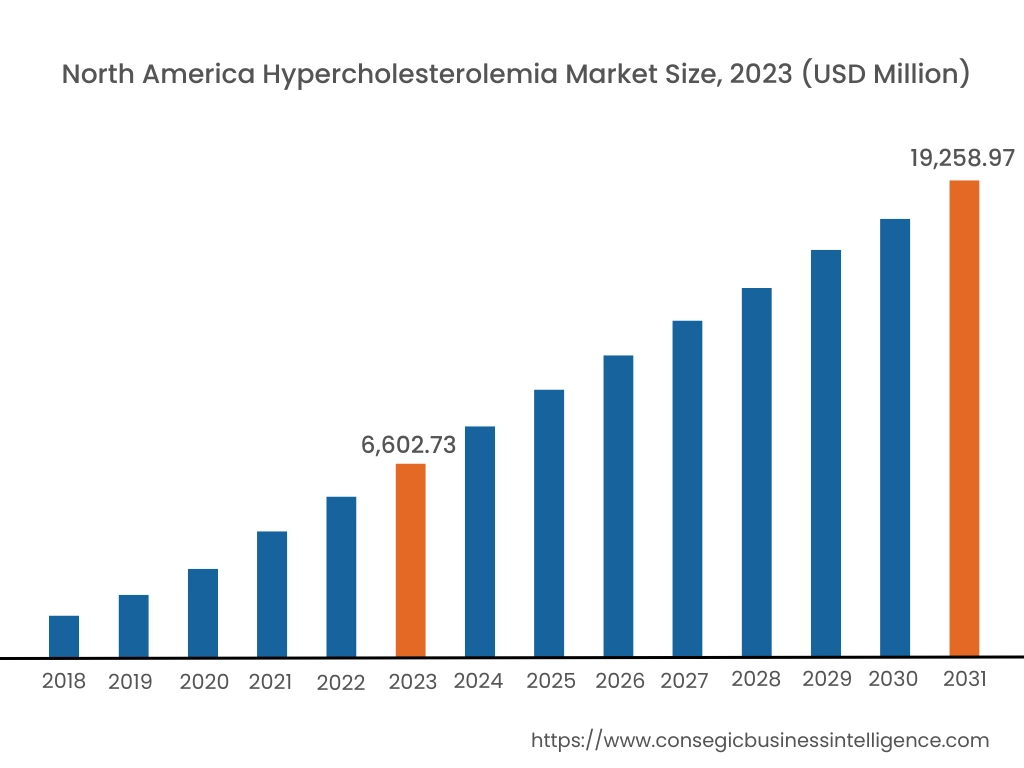
In 2024, North America was valued at USD 6,365.23 Million, and is expected to reach USD 20,615.25 Million in 2032. In North America, the U.S. accounted for the highest market share of 67.12% during the base year of 2024. Based on the hypercholesterolemia market analysis, North America has a well-established healthcare infrastructure, with a high number of hospitals, clinics, and pharmacies. This makes it easy for people with this condition to access drugs and treatment for this condition. Moreover, the high prevalence of this condition across the region is driving the demand for treatment across the region.
- In May 2023, according to the Centers for Disease Control and Prevention, 86 million U.S. adults have total cholesterol levels above 200 mg/dL, which is higher than the normal range.
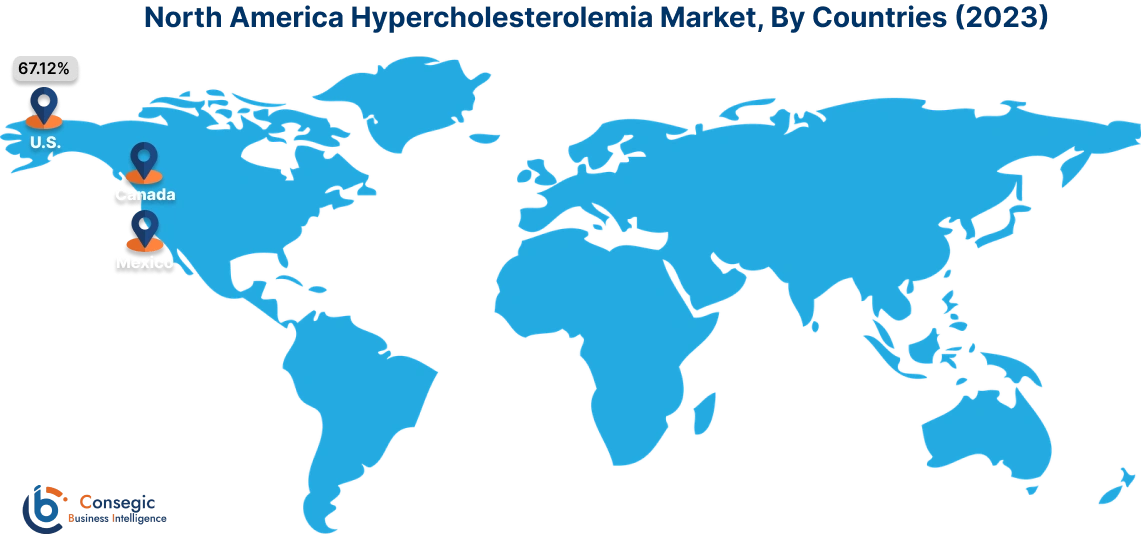
Asia Pacific is expected to witness the fastest CAGR over the forecast period of 17.1% during 2025-2032. There is a growing awareness of hypercholesterolemia management in the Asia Pacific region. Governments in the Asia Pacific region are increasing their support for hypercholesterolemia management. This is leading to increased access to drugs and other essential supplies, which is expected to create lucrative growth prospects for the hypercholesterolemia market across the region over the forecast period. All these above-mentioned factors are collectively boosting the market across the Asia Pacific region and creating lucrative growth prospects for the hypercholesterolemia market demand in the Asia Pacific region.
In Latin America, the hypercholesterolemia market is witnessing a rise due to increased awareness of cardiovascular diseases and growing access to healthcare services. The adoption of various treatment options, including statins and PCSK9 inhibitors, is expected to grow as patients seek effective management strategies. The region's focus on public health initiatives is also driving market trends.
In Europe, the hypercholesterolemia market is growing, driven by rising obesity rates and increased cardiovascular disease awareness. Statins remain the primary treatment, but newer therapies like PCSK9 inhibitors are gaining traction. Efforts to enhance screening and preventive care are also shaping market dynamics, fostering a shift toward personalized medicine.
In the Middle East and Africa, the hypercholesterolemia market is influenced by increasing awareness of cardiovascular health, rising obesity rates, and genetic predispositions. Statin therapies dominate, but newer treatments like PCSK9 inhibitors are gaining traction. Additionally, lifestyle changes and healthcare access improvements are vital for managing cholesterol levels effectively.
Top Key Players & Market Share Insights:
The Hypercholesterolemia market is highly competitive with major players providing treatments to the national and international markets. Key players are adopting several strategies in research and development (R&D), product innovation, and end-user launches to hold a strong position in the global Hypercholesterolemia market. Key players in the Hypercholesterolemia industry include-
- Novartis AG (Switzerland)
- Lilly (United States)
- Sun Pharma (India)
- Amgen Inc (United States)
- Bristol-Myers Squibb (United States)
- Teva Pharmaceuticals Industries Ltd (Isreal)
- Dr Reddy's (India)
- AstraZeneca (UK)
- Merck & Co., Inc (United States)
- Lupin Pharmaceuticals (India)
- Sanofi (France)
Recent Industry Developments :
Product Enhancement:
- In March 2024, The Food and Drug Administration (FDA) expanded the approval of Nexletol® (bempedoic acid 180mg tablets) and Nexlizet® (bempedoic acid 180mg and ezetimibe 10mg tablets). This expansion includes the prevention of myocardial infarction (MI) and coronary revascularization in adults at high risk for cardiovascular disease (CVD) events but without established CVD, as well as those with established CVD, regardless of statin use.
Announcement:
- In August 2023, Novartis presented long-term data for Leqvio (inclisiran), demonstrating consistent efficacy and safety in lowering LDL cholesterol over six years. The findings, highlighted at the European Society of Cardiology Congress, emphasize Leqvio's potential as a transformative therapy for patients at high cardiovascular risk, reinforcing its role in cholesterol management.
Hypercholesterolemia Market Report Insights :
| Report Attributes | Report Details |
| Study Timeline | 2019-2032 |
| Market Size in 2032 | USD 63,607.67 Million |
| CAGR (2025-2032) | 16.2% |
| By Type |
|
| By Usage |
|
| By Route of Administration |
|
| By Distribution Channel |
|
| By Region |
|
| Key Players |
|
| North America | U.S. Canada Mexico |
| Europe | U.K. Germany France Spain Italy Russia Benelux Rest of Europe |
| APAC | China South Korea Japan India Australia ASEAN Rest of Asia-Pacific |
| Middle East and Africa | GCC Turkey South Africa Rest of MEA |
| LATAM | Brazil Argentina Chile Rest of LATAM |
| Report Coverage |
|
Key Questions Answered in the Report
How big is the hypercholesterolemia market? +
In 2024, the hypercholesterolemia is USD 19,189.23 million.
Which is the fastest-growing region in the hypercholesterolemia market? +
Asia Pacific is the fastest-growing region in the hypercholesterolemia market.
What specific segmentation details are covered in the hypercholesterolemia market? +
Type, Usage, Route of Administration, and Distribution Channel are the segmentation details covered in the hypercholesterolemia market.
Who are the major players in the hypercholesterolemia market? +
Novartis AG, Eli Lilly and Company, Dr Reddy’s, Sun Pharma, AstraZeneca, Amgen Inc, Bristol-Myers Squibb, Merck & Co., Inc., Lupin Pharmaceuticals, Sanofi, Teva Pharmaceuticals Industries Ltd. are the current major players of the market.
